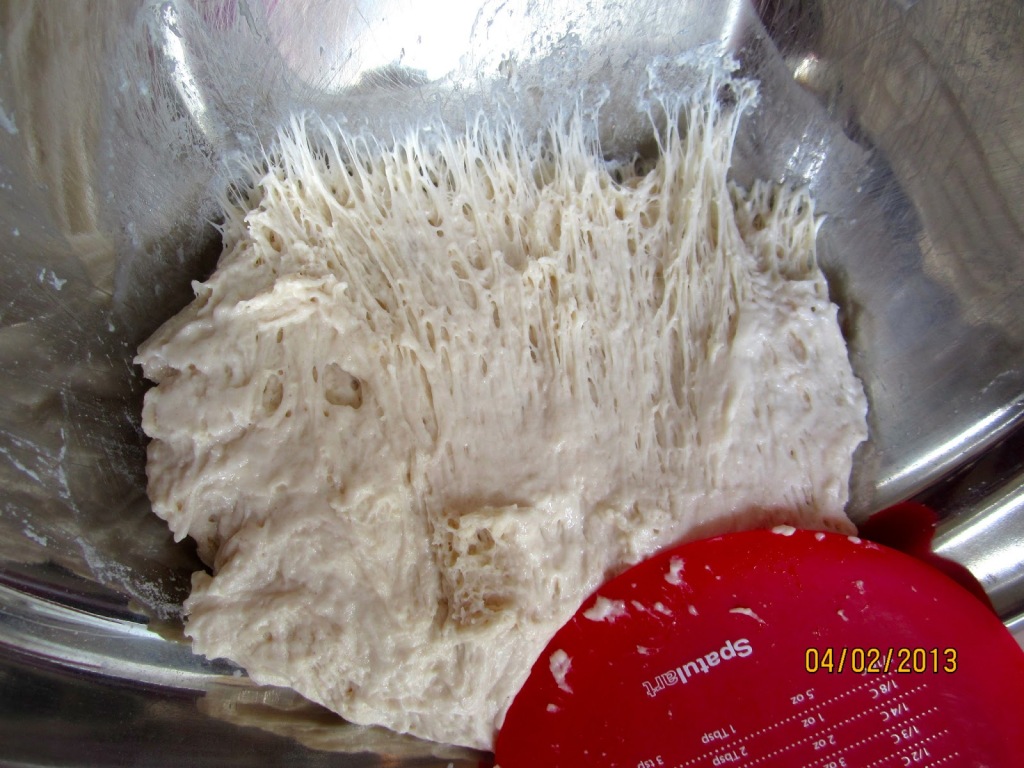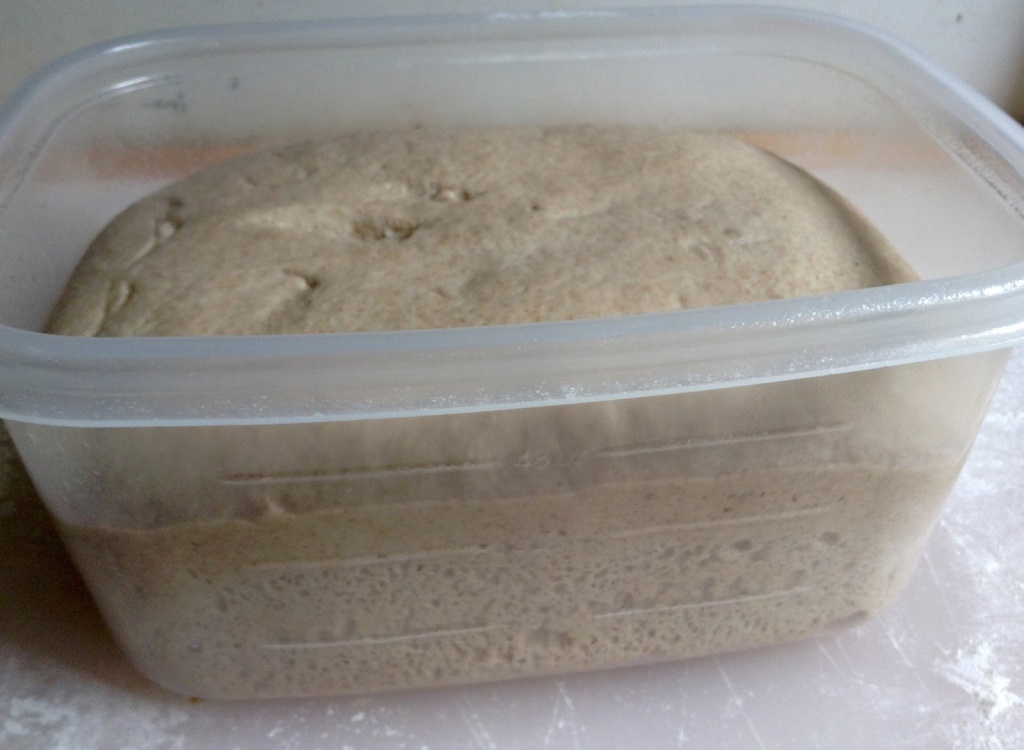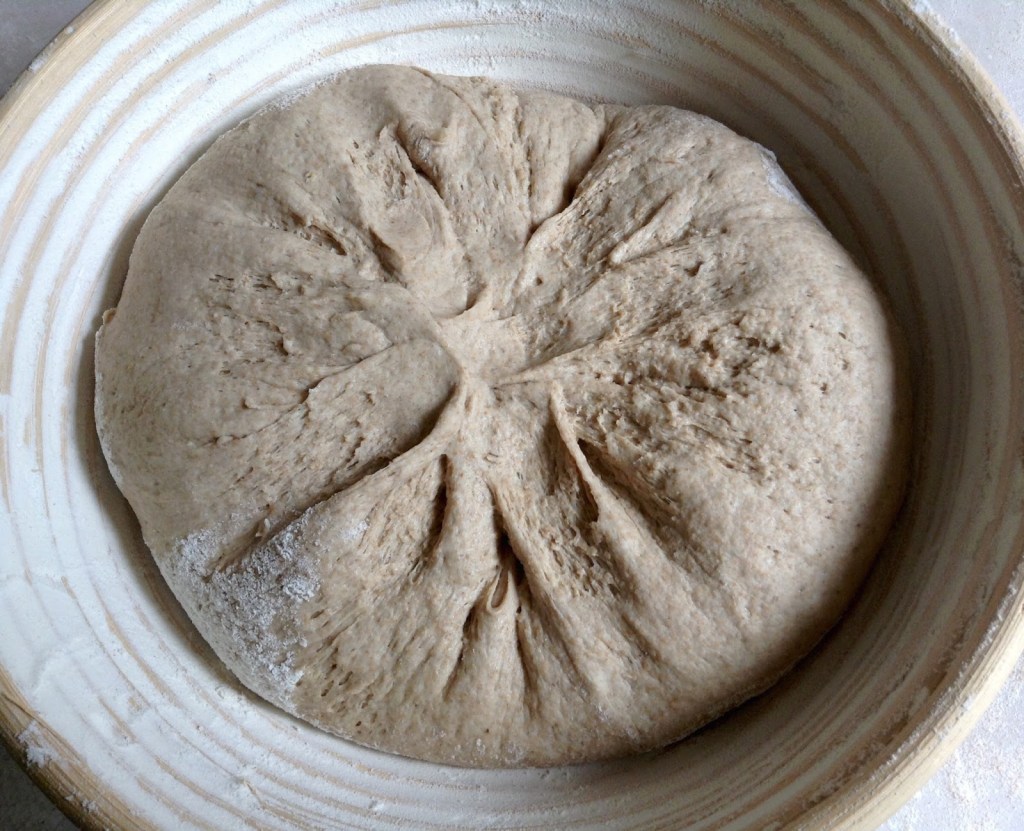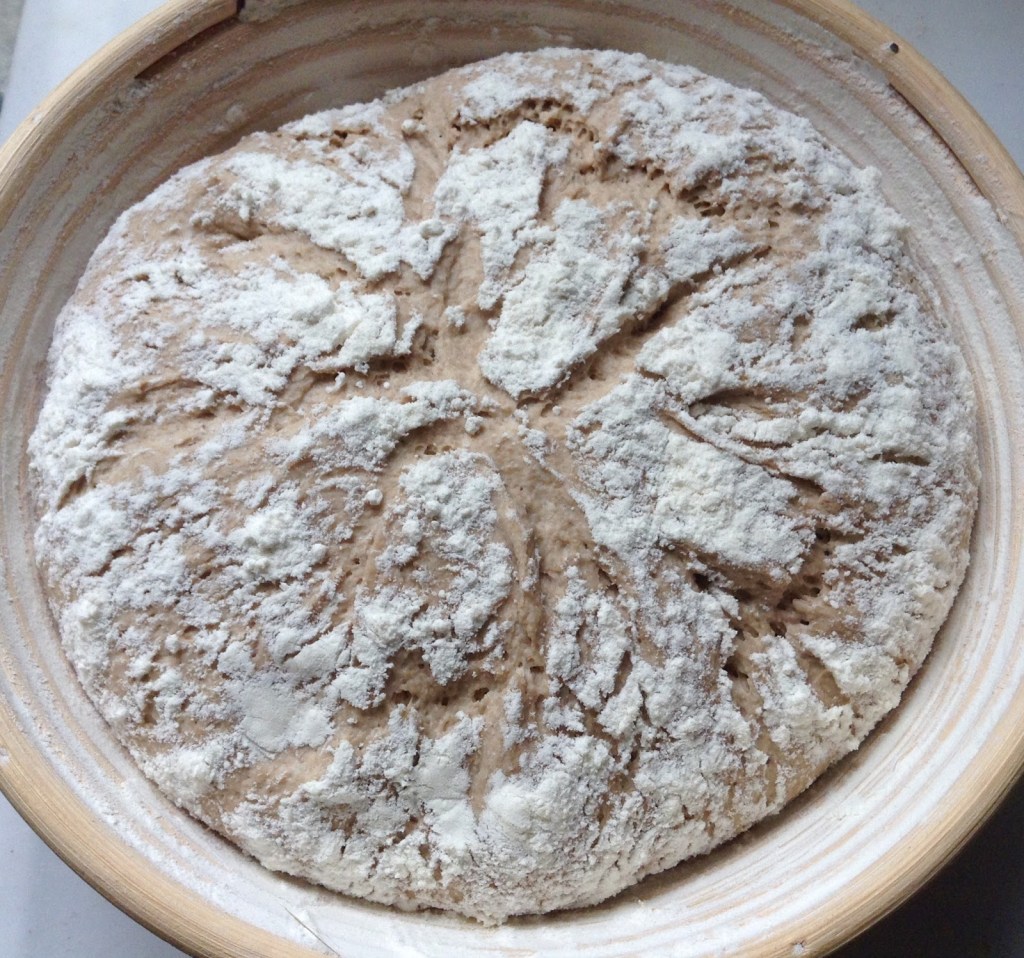When I moved to Maine in 2001 – to get even with the guy who had sold me a houseful of furniture, but refused to give me a discount – I knew I would be in big trouble. And I was right!
After two days my stomach started complaining, and my brain kept sending “gag” signals, when I walked the supermarket aisles and encountered nothing but shelf after shelf of “Wonderbreads”.
Poking one of those proudly-called rye, multigrain, oat nut, or wheat breads with my finger, I found no resistance. I could squeeze them through their plastic bags, and they would spring right back to their original size when I let go. Even toasted, they retained their squishyness and would not support butter or jam without getting soft and soggy.
Eating two warm meals a day was another thing my stomach refused to accept. German families usually have bread and cold cuts either for lunch or for dinner. German schools don’t offer lunch, and Mom cooks at home.
As a working mom I used to view this daily cooking as a chore, and bad idea – until my daughter went to Bangor High, and had to eat at the school cafeteria (this experience turned her into a cook, and gave birth to a career as chef!).
Finally, I couldn’t take my stomach’s growling anymore. I started seeing bread mirages by day, and dreamed of crusty loaves by night. So I went on a quest for German everyday bread, Feinbrot.

The first step was, of course, to find a recipe. That was, in 2001, a big hurdle. No one in Germany baked Feinbrot at home, you could get several varieties in every bakery and supermarket.
My baking books and the internet offered only recipes for specialty breads, but not for the simple loaf I was looking for. And Feinbrot is usually baked with medium rye flour, but I was lucky to find whole rye flour, if any.

And how to make sourdough? I didn’t have the slightest idea! But then I found a recipe for Pain au Levain, made with sourdough, in the “French Farmhouse Cookbook“.
Full of enthusiasm I mixed my first starter from the scratch, and, also, as backup and for comparison, another starter from a store-bought package.
My first two breads, twin loaves from the two different starters, resulted in two almost identical bricks!
Stubbornly, I kept on baking, producing more bricks on the way – my husband suggested having a supply next to our bed in case of a home invasion – and experimented with different amounts of rye, wheat, temperatures and baking times.
After several weeks (and bricks!) my homemade starter was way ahead of the store bought mix, both in flavor and activity. Slowly, by trial and error, I figured out what bread flour/rye ratio worked best, and which temperatures and baking times delivered the best results.
An open house tour with my daughter at the New England Culinary Institute in Burlington, Vermont, left me green with envy. Valerie was going to learn how to make baguettes – from a real French pastry chef! I went home, and, since I couldn’t be one, at least I could buy “The Bread Baker’s Apprentice“.
Reading Peter Reinhart’s instructions I was struck by an epiphany! I had always (as stated in my recipes) just placed a cup with cold water in the oven. Though my breads had the right taste and right crumb, the crust was rather chewy and thick. But now I learned how to set up my oven for hearth baking – with a baking stone and STEAM!

With the discovery of steam, my humble Feinbrot was transformed! Flavorful, a bit tangy, with a thin, crisp crust, it tastes good with cold cuts, but also with honey or jam.
We especially like it with Fleischsalat, the typical German meat salad, made with ham and pickled cucumbers! You can also toast it, which I do when it’s more than two days old.

If you want your Feinbrot to be somewhat tangy (as we do), you can use unrefreshed starter from the fridge (the longer it was hungry, the tangier the bread will taste) But don’t use an unfed rye starter, or your bread will be too acidic!
My default mother starter is a whole wheat sourdough at 75% hydration. If your starter is 100% hydrated (flour/water ratio 1:1), see note below to adjust the flour and water amounts.
GERMAN FEINBROT
SOAKER
192 g/6.77 oz whole rye flour
64 g/2.25 oz whole wheat flour
4 g/0.14 oz salt (1/2 tsp)
195 g/6.87 oz water
WHITE STARTER
195 g/7 oz whole wheat mother starter (75% hydration) – for a 100% hydrated starter, see note below *)
200 g/7 oz bread flour
120 g/4 fl oz water, lukewarm
*) If your starter is 100% hydrated (50% flour/50% water), add 49 g/1.72 oz whole wheat flour and reduce the water amount to 71 g/2.5 oz.
FINAL DOUGH
all soaker and starter
56 g/2 oz bread flour
10 g/0.35 oz salt
1 g/0.03 oz ground bread spices (anise, caraway, fennel and/or coriander **)
**) For easier use, put equal amounts of anise, caraway, fennel in a spice mill, and give it a couple of turns. I like to make some breads with coriander only, therefore I use a separate mill for it.
DAY 1
In small bowl, stir together soaker (it will be rather stiff). Cover, and leave at room temperature overnight.

In second bowl, mix white starter. Cover, and leave at room temperature overnight. It should show a spongy structure underneath when it’s ripe.

DAY 2 (Morning)
Mix together all ingredients for final dough, 1 – 2 minutes at low speed (or by hand), until all flour is hydrated, and a coarse ball forms. Knead 4 minutes at medium-low speed (dough should be somewhat sticky). Let dough rest for 5 minutes, then knead for 1 more minute (dough should be very tacky, bordering on sticky).

Place dough in an oiled bowl or container, cover, and let rise at room temperature, approximately 4 – 5 hours, or until it has grown to about 1 1/2 times its original size.

Transfer dough to a lightly floured work surface. Shape into a boule, and place it in a floured rising basket, seam-side up.
Proof at room temperature for about 2 1/2 – 3 1/2 hours, or until the bread has grown about 1 1/2 times its original size, and a dimple, made with your finger, comes back a little bit, but remains visible. (Preheat oven about 3/4 hour before you expect to bake!)
Preheat oven to 500ºF/260ºC, with steaming device (I use an aluminum foil loaf pan, filled with pebble stones) and a baking stone.

Turn bread out onto a parchment lined baking sheet (or on a peel to bake directly on the stone). Score your loaf.
Place bread in oven, creating steam with your preferred method (I pour a cup of boiling water into my steam pan). Reduce temperature to 475ºF/246ºC.
Bake bread for 10 minutes, then lower the oven temperature to 425ºF/218ºC. After 10 minutes, remove steam pan, rotate loaf 180 degrees for even browning, and continue baking for another 20 minutes, or until crust is deep golden brown, bread sounds hollow when thumped on the bottom, and an instant read thermometer registers at least 200ºF/93ºC.
Let bread cool on a wire rack.
STORAGE: Keep Feinbrot 1-2 days in a brown paper bag, then wrap it in plastic foil (and toast it). I usually freeze half of my bread soon as it’s cold. (Thaw at room temperature.) Never store homebaked bread in the fridge, it will get stale!
BreadStorm users (also of the free version) can download the formula:
http://bunfiles.breadstorm.com/bunfiles/RWY79E/DT624C/embed.html

VARIATIONS:
Feinbrot with spelt:
Replace the rye and whole wheat flours in the soaker with 256 g spelt flour, use only coriander instead of spice mix.
Feinbrot with oat:
Replace the rye in the soaker with oat flour.
Feinbrot with nuts:
Add a handful of toasted nuts to the dough (I like it with whole hazelnuts).

Updated and rewritten post (first published 10/31/10)
Submitted to Yeast Spotting
Hey, Happy Thanksgiving, I know not your holiday but celebrate anyway!! Thanks for the update. My rye starter is sour which is perfect for this:
https://www.cooked.com/uk/Trine-Hahnemann/Quadrille-Publishing/Scandinavian-Baking/Breads-and-savouries/My-class
I bake it every 3 weeks and have a RAADVAD to slice it.
stay warm.
LikeLike
Thank you. Our Thanksgiving is in 2 weeks, and after that I‘m escaping the cold for a short trip to Mexico. I own Trine Hahnemann‘s baking book, but haven’t tried anything yet.
LikeLike
Thank you for your step-by-step recipe. I too miss the bread from Germany.
LikeLike
Fortunately, in the meantime you can get better bread here, but no Feinbrot.
LikeLike
I’m an avid bread Baker but I’m not familiar with this particular type of bread, so that’s pretty interesting to me. I loved all your bread baking comments and they’re right on. But what I most want to know about is the notion that you moved to Maine just to get even with some guy who didn’t give you a discount! That’s got to be a story worth telling.
LikeLike
That’s the same guy who always wanted cherry pie as birthday cake, and then compared it unfavorably to his mother’s! But he makes the best Pasta Bolognese, so I guess I got the discount’s worth after all 😉
LikeLike
Wow this looks fabulous!!!
LikeLiked by 1 person
Thank you, dear Diane. Happy New Year!
LikeLiked by 1 person
Hi Karin–If your starter is 75% flour and 25% water by weight, then it’s a 33% hydration starter, because the water is one-third the weight of the flour.
LikeLike
John, you put your finger on a sore spot – math was never my strong suit. Thanks!
LikeLike
Hi Karin
I’m late to the party here, but wanted to comment on the subject of hydration with particular reference to the comments made by John from PA above.
You don’t state what the exact measurements of flour and water are in your mother sponge, but tell us that it is at 75% hydration. Looking at the photo of your trusty whole wheat starter, that seems about right.
I think John from PA is discounting “Baker’s Math” where percentages of all ingredients is with reference to the total weight of the flour. i.e. your mother sponge would be 75g of water for every 100g of flour.
I’m baking half a dozen rye loaves and half a dozen basic San Francisco style white loaves this morning in my domestic oven, so it’s time to turn the oven on now. No baking stone for me. I use upturned baking sheets on two shelves so that I can accommodate 6 x 600g loaves.
I found your blog on the Freshloaf.com. Great website to learn from other bakers.
Stay safe.
LikeLike
Yes, that’s right for the 75% hydration of my WW mother starter. Anyway, you always have go go by what your eyes and fingers tell you about how much water is needed (keeping in mind Peter Reinhart’s pearl of wisdom: “Always err on the side of too wet than too dry”).
6 medium sized loaves was my output per batch, too, when I had my micro-bakery. I used the stone mainly to help keeping the temperature even, always baked on parchment lined baking sheets (or perforated, for rolls).
Stay safe, too!
LikeLike
Don’t you have your micro-bakery anymore, or have you moved up to a commercial space now?
LikeLike
No, we downsized and moved into a condo with a smaller kitchen and less storage space. I baked for 10 years for our local natural food store, and enjoyed it hugely, but that was a unique opportunity in Bar Harbor, and would have been difficult to do here in Portland.
LikeLike
Oh! That’s too bad that you feel you can’t continue in the same vein, but I’ll agree that the smaller the space, the more difficult it is to bake in quantity without displacing everyday requirements.
I’m lucky that we have plenty of space and can bake for a local farm market in the summer and a kitchen equipment/bedroom linens boutique all year round.
LikeLiked by 1 person
How nice! What I, also, found very rewarding about baking for customers is how much I learned by just doing it.
LikeLike
That’s true and I’m hoping to keep on learning.
One of my “to do” projects is to try that Weizenbrotchen recipe that you published. When I first started selling my sourdough bread at the local farm market, I had a couple of older German customers, who asked me if I could bake some crusty rolls like they could get in Germany. I tried several recipes without success, but yes, when you consider the difference in protein content between European and Canadian wheat, that may have been the problem I was running into.
I’ll let you know how it goes.
LikeLiked by 1 person
Please do, John! I know in Germany bakeries use some roll enhancer mix and churn them out after a brief rise. I think my formula comes at least pretty close to the “normal, everyday” white rolls.
LikeLike